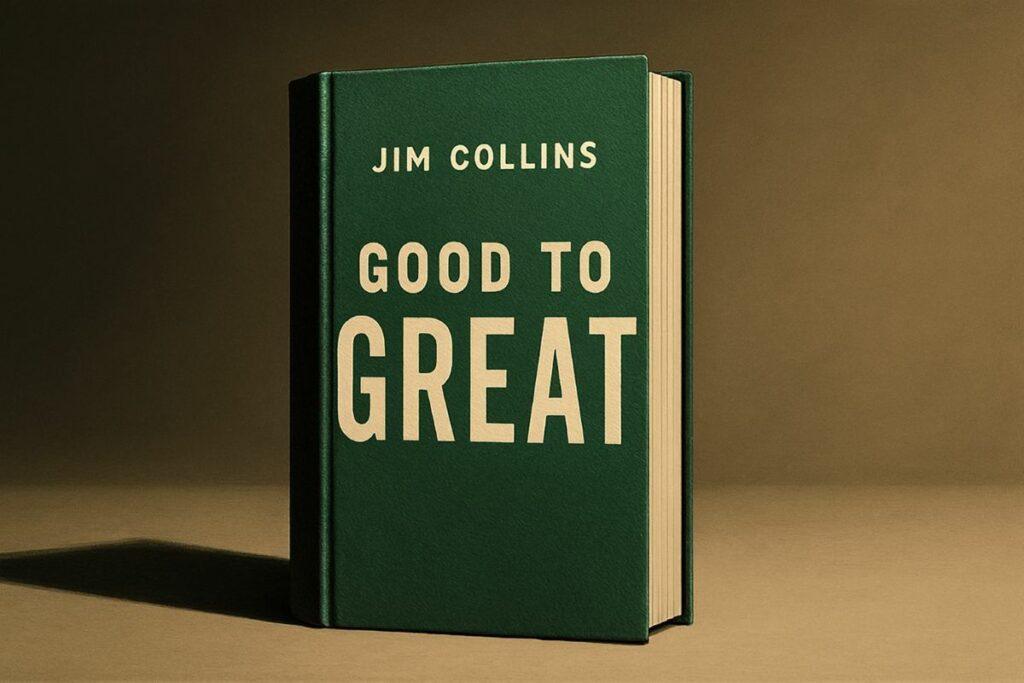The flywheel effect mental model changes how we see lasting success in business and personal growth. Think of Amazon’s constant push for customer happiness or Apple’s steady stream of new ideas. Each small step adds up, like spinning a heavy iron wheel.
Jim Collins introduced this idea in Good to Great. It shows that steady effort beats quick fixes. Daily actions can lead to huge results over time. By sticking to core values, like Toyota’s quality or Netflix’s user experience, we can grow in a lasting way.
Greatness doesn’t happen overnight. It grows through daily choices aligned with what matters most. Think of each small win as a push that keeps your wheel turning faster.
Over time, these efforts compound—creating results that surprise everyone except those doing the work.
Key Takeaways
- Jim Collins’ research shows lasting success comes from consistency, not sudden breakthroughs
- Momentum builds when efforts align with unchanging core values
- Amazon’s strategy focused on stable customer needs, not temporary trends
- Flywheel mental model: Exponential growth starts with small, repeated actions
- Progress often feels gradual until momentum takes over
The flywheel effect mental model teaches us to value persistence over shortcuts. Like turning that heavy wheel, meaningful change begins with showing up—day after day—for what truly lasts.
How the Flywheel Effect Mental Model Builds Lasting Success

The flywheel effect mental model shows why some companies, like Walmart or Microsoft, stay on top for years. It’s not just one big win. It’s about a series of small, smart steps that grow bigger over time. Think of it like a snowball getting bigger as it rolls down a hill.
Jim Collins’ work in Good to Great highlights this. He found that great companies focus on their strengths. Walmart works hard on its supply chain, and Microsoft improves its software. This creates a cycle where each improvement helps the next, leading to fast growth.
This model teaches us to value steady effort over quick fixes. McKinsey’s study shows that steady strategies beat unpredictable ones by 20% in 10 years. By focusing on what’s most important, like customer trust or quality, you build a system that grows on its own.
The secret is patience: small steps today add up to big wins tomorrow.
Overview of the Flywheel Effect Mental Model
What separates organizations that thrive for decades from those that fade quickly? The answer lies in systems that grow stronger with each step forward. Like a spinning flywheel gaining speed, small daily efforts create energy and forces that build on themselves. Turning initial struggles into unstoppable business progress that adds value to the people involved.
Breaking Down the Core Idea
At its heart, this strategy focuses on interconnected actions. Each decision feeds into the next, creating cycles where today’s work makes tomorrow’s tasks easier. Jim Collins’ research revealed that exceptional companies design their entire operations around these reinforcing loops rather than chasing temporary wins.
Think of a bicycle wheel. The first push demands energy, but once rolling, it carries itself forward. Similarly, businesses that identify their essential strengths—like customer trust or product quality—invest in them relentlessly. Over time, these priorities become ingrained habits that drive growth.
Why Consistency Outshines Quick Fixes
Lasting success rarely comes from sudden breakthroughs. It emerges through repeated actions aligned with unchanging goals. A coffee shop perfecting its brew method year after year, for example, builds a reputation that attracts loyal customers naturally.
The real power lies in patience. Early efforts might feel insignificant, but compounded over months and years, they transform into competitive advantages no rival can easily copy. This approach thrives on clarity—knowing what matters and refusing to divert resources to distractions.
Origins and Fundamentals of the Flywheel Concept

How do ordinary efforts transform into extraordinary results over time? The answer emerged from decades of research into what separates truly exceptional organizations from those that plateau. At the heart of this discovery lies a principle as old as physics—yet revolutionary in its business applications.
The Role of Jim Collins and “Good to Great”
Jim Collins spent 25 years studying companies that leaped from average to iconic. His team analyzed over 6,000 years of combined corporate history. Their findings? Lasting success never comes from flashy campaigns—it grows through daily choices aligned with core values.
In his book Good to Great, Collins revealed a pattern: thriving organizations focused on one repeating process. They ignored trends and instead doubled down on what wouldn’t change. A retailer improving inventory systems year after year, for example, eventually outpaced competitors chasing fads.
Mechanical Metaphor and Momentum
The concept borrows from heavy machinery. Early pushes seem futile—until stored energy propels the system forward. Great leaders described their success as an inevitable outcome of accumulated effort, not a single breakthrough moment.
Collins found struggling companies often switched strategies like changing clothes. In contrast, winners kept turning their wheel. A tech firm refining user experience for a decade, for instance, built advantages no newcomer could replicate overnight.
This approach reshaped how we view progress. Small, consistent turns—not grand gestures—create unstoppable momentum. The real magic happens when effort compounds silently before erupting into visible success.
The Flywheel Effect in Business: The Amazon Case Study
In 1997, a struggling online bookstore made a bet that would redefine retail forever. Amazon’s leadership team focused on three non-negotiable principles: rock-bottom prices, endless product variety, and rapid delivery. These choices became the fuel for a growth engine that now serves over 300 million active accounts.
Reinvestment Strategies and Synergy
Jeff Bezos famously plowed profits back into systems that enhanced customer value. Lower prices attracted more buyers, which drew third-party sellers to the platform. As selection grew, Amazon spread fixed costs across more transactions—enabling even deeper discounts.
The company’s 2001 collaboration with Jim Collins solidified this approach. Instead of chasing quarterly earnings, Amazon invested in infrastructure and technology. This created a loop where customer trust translated into market dominance. Bezos summarized it bluntly: “Your margin is my opportunity.”
Today, this strategy generates $500+ billion annually. The true brilliance lies in how each element strengthens the others. More sellers mean better prices, which drive higher traffic, attracting more sellers.
It’s not just a business model—it’s a perpetual motion machine built on delivering what customers always want.
Amazon’s story proves that short-term sacrifices can forge unbreakable competitive advantages. By keeping their wheel spinning around core values, they turned simple ideas into world-changing products and services.
Small Steps, Big Impact: Consistency Over Time

Why do some people achieve lasting results while others stall after quick wins? The answer lies in daily choices that stack like bricks—each one seemingly ordinary, but together forming an unshakable foundation.
Research reveals even modest efforts, like 150 minutes of weekly exercise, create life-changing health improvements when sustained over years.
Continuous Improvement and Compounding Effort
True transformation happens when small actions become automatic. Walking 30 minutes daily seems trivial today. But after 100 days? You’ve moved 50 miles farther than someone who quit week three. This “invisible math” separates temporary attempts from lifelong change.
| Approach | Weekly Effort | 1-Year Result | 5-Year Impact |
|---|---|---|---|
| Sporadic Intensity | 4 hours (occasional) | Short-term gains | Plateau or burnout |
| Consistent Moderation | 2.5 hours (steady) | Habit formation | Lasting health benefits |
| Daily Micro-Actions | 20 minutes (daily) | Skill development | Mastery & opportunities |
Real-World Examples in Fitness
Consider marathon training. No runner completes 26 miles on day one. They build endurance through incremental increases—a strategy mirrored in career growth or learning new skills. Investor Howard Marks notes that discomfort often signals worthwhile pursuits, since easy paths attract crowds.
The challenge? Early progress hides in plain sight. Muscle gains take weeks to show. Savings accounts grow slowly. Yet those who persist discover their efforts suddenly multiply—like a snowball rolling downhill. This principle explains why 94% of New Year’s resolutions fail by June, while steady planners achieve 80% more goals annually.
Lasting success isn’t about heroic efforts. It’s showing up consistently, even when results feel distant. What small step could you take today that future you will thank you for?
Practical Steps to Apply the Flywheel Effect Personally
The flywheel effect isn’t just for businesses—it’s a game-changer for personal growth too. Start by picking a core goal, like mastering a skill or getting healthier. Break it down into small, daily actions.
For example, writing 200 words daily towards a novel might seem small. But in a year, you’d have a 73,000-word draft. Consistency is key. A 2023 study from Harvard found that daily habits stick 80% more than sporadic efforts.
Like Google’s constant updates to its search algorithms, your small steps add up over time. They build momentum.
To make this work, track your progress and stay focused. Use tools like habit-tracking apps or simple journals to see your progress. Celebrate small wins, like a week of workouts, to keep you motivated.
Over time, these efforts will compound, turning your personal flywheel into a powerhouse of achievement. Just like how Starbucks built its global brand through consistent customer experience improvements.
How the flywheel effect mental model Drives Exponential Growth
Why do companies like Toyota and Apple keep winning decade after decade? Their secret lies in building systems where every victory fuels the next breakthrough. This approach transforms gradual progress into market dominance that outlasts trends.
The Self-Reinforcing Loop in Business Strategy
Great organizations design their operations like gears in a clock. Each department’s success directly enables another’s progress. A logistics team’s speed improvements, for example, let marketing promise faster deliveries—which attracts more customers to fund better logistics.
| Strategy | Focus | 5-Year Growth | 10-Year Impact |
|---|---|---|---|
| Reinforcing Loops | Customer retention | 150% revenue increase | Market leadership |
| Short-Term Wins | Quarterly targets | 30% revenue spike | Frequent strategy shifts |
| Static Planning | Annual budgets | 5% steady growth | Gradual decline |
Long-Term Thinking in Company Growth
Collins observed that thriving companies stick with their core strategy for 10+ years. They resist chasing shiny new markets, knowing real power comes from deepening existing strengths.
A tool manufacturer improving durability since 1995, for instance, now dominates its niche through unmatched reliability.
The toughest part comes when early efforts show little reward. But those who persist discover their systems eventually multiply results—like planting oak trees that later create entire forests. What could your team achieve by refining one process for five straight years?
Applying the Flywheel to Thought Leadership and Personal Transformation

True influence grows like a snowball rolling downhill—small at first, then unstoppable. Leaders who shape industries don’t chase viral moments. They build systems where each action strengthens the next, creating lasting impact through steady effort.
Building Momentum in Your Thought Leadership Journey
Great communicators focus on what never changes. Clear storytelling beats algorithm hacks. Trust outlasts trends. By creating valuable content weekly—even when audiences seem small—you lay tracks for future growth.
Consider how industry experts rise. They answer the same core questions for years, refining their message. Each article or speech becomes a building block. Over time, their ideas reach more people through word-of-mouth and search engines.
| Strategy | Focus Areas | 1-Year Result | 5-Year Impact |
|---|---|---|---|
| Trend Chasing | New platforms | Spikes in followers | Relevance fades |
| Core Messaging | Timeless principles | Slow audience growth | Industry authority |
| Relationship Focus | Mentorship & collaboration | Strong network | Exponential opportunities |
Transforming Personal and Professional Strategy
Your career thrives when daily actions connect. Learning one skill this month makes next quarter’s project easier. Helping a colleague today might lead to a leadership role tomorrow.
The best professionals design their growth like engineers. They identify key areas—communication, technical skills, emotional intelligence—and improve them systematically. This creates access to better roles and partnerships naturally.
What three habits could you start today that would compound into career-changing results by 2029? The answer lies not in grand plans, but in choosing consistency over convenience.
Flywheel Effect vs. Other Mental Models

The flywheel effect mental model is unique, focusing on building momentum over time. Unlike the 80/20 rule, which tells us to focus on high-impact tasks, the flywheel effect shows how consistent effort in all areas leads to big results. For example, Netflix uses its flywheel of content and user data to offer personalized recommendations, which helps it grow.
A 2024 report by Deloitte found that companies using the flywheel effect saw a 25% increase in customer retention. This is compared to those focusing on quick fixes. This shows the power of compounding efforts.
Unlike systems thinking, which looks at complex interactions, the flywheel effect makes success simple. It tells us to focus on a few key areas, like Apple’s design or Tesla’s speed. This approach helps avoid distractions and ensures we keep improving what works.
Cross-Industry Applications: Beyond Traditional Business Strategies
Across sectors, leaders are discovering how interconnected systems create lasting momentum. From hospitals improving patient care to schools boosting graduation rates, the principles work where traditional plans fail. Success comes from designing cycles where every action fuels the next.
Flywheel Effect Mental Model: Marketing That Builds on Itself
HubSpot reshaped digital outreach using three phases. First, attract through helpful content and SEO. Then, engage with personalized messages across channels. Finally, delight by solving issues before they arise. This approach turns satisfied clients into brand ambassadors naturally.
Teams That Grow Stronger Together
Forward-thinking companies use the “Rule of 3” for staff development. Address survey results within three weeks. Choose three improvement areas. Share updates three different ways. Regular check-ins keep teams aligned and energized—like tuning an engine for peak performance.
Thriving Through Market Shifts
Adaptable organizations focus on core customer needs that outlast trends. A farm equipment maker might streamline maintenance processes while competitors chase flashy tech. By deepening what matters most—reliability, service speed, fair pricing—they build trust that weathers economic storms.
The real magic happens when organizations stop chasing quick wins. Like planting sequoias, they invest in systems that grow more valuable with time. What enduring value could your team nurture today?
Conclusion
The flywheel effect mental model reveals a simple truth: small, consistent actions create unstoppable momentum. From Amazon’s customer-driven growth to an individual’s daily habit of learning, this strategy proves that persistence beats shortcuts.
Jim Collins’ Good to Great showed that companies like Coca-Cola and Intel built empires by focusing on core strengths over decades, not chasing trends. A 2025 study by Bain & Company found that consistent strategies yield 30% higher long-term profits than reactive ones.
To apply this model, identify what matters most—whether it’s customer trust, personal skills, or team efficiency—and take one small step today. Like a flywheel gaining speed, your efforts will compound, turning modest beginnings into transformative results.
What’s the one action you can commit to daily to spin your flywheel toward greatness?


